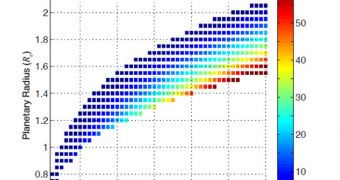For many years, astronomers have believed that planets existing beyond our solar system couldn't have been protected by a magnetic field similar to our planet's, especially if they were Earth-sized or smaller.
As you all know by now, discovering Earth-like planets around dwarf stars or Sun-like stars is the main objective in exoplanetary research. Such a celestial object could provide a second home for us in case things turn sour here.
But one of the main conditions that a planet needs to fulfill in order to be considered fit to support even the most basic life forms is to have a magnetic shield protecting its surface from its parent star's radiation.
Earth has such a shield, in the upper layers of the atmosphere, and it prevents solar radiation, including ultraviolet (UV) rays, from passing through. If they did, then our genetic material would slowly be destroyed. Life as we know it would disappear.
This renewed interest in studying the possibility of a magnetic field existing around a planet similar to our own was elicited after astronomers announced the discovery of “Second Earth” in September.
The exoplanet, called Gliese 581g, is about three times as massive as Earth, and it orbits its parent star at a distance smaller than Mercury's to the Sun. But its parent star is a dwarf star, which means it produces a lot less radiation than our own.
The object is tidally-locked to its parent star, which means that it always keeps the same face oriented towards the cosmic fireball. As a result, temperatures on the dark side reach about -4 degrees Celsius, while those on the day side reach an average of about 70 to 80 degrees Celsius.
As such, astronomers say that there must certainly be a certain region on Gliese 581g's surface where conditions are just right for the existence of liquid water.
But, in order for a magnetosphere to develop, the planetary core needs to spin like a dynamo, driven by surrounding convection currents that form a dipole magnet, and the rotation of the planet itself. But this does not happen in a tidally-locked system.
Recently, Carnegie Institution of Washington researchers led by Natalia Gómez-Pérez proposed that dipoles can indeed form on certain exoplanets, provided that their cores are less dense than our own.
If the cores are made of lighter chemical elements, and are a lot larger (such as is the case with Gliese 581g), then they could allow for the development of a magnetic dipole strong enough to produce a magnetosphere.
“We predict that planets close-in to the star may have significant magnetic fields that allow a magnetosphere to be present,” Gómez-Pérez explains, quoted by Technology Review.

 14 DAY TRIAL //
14 DAY TRIAL //